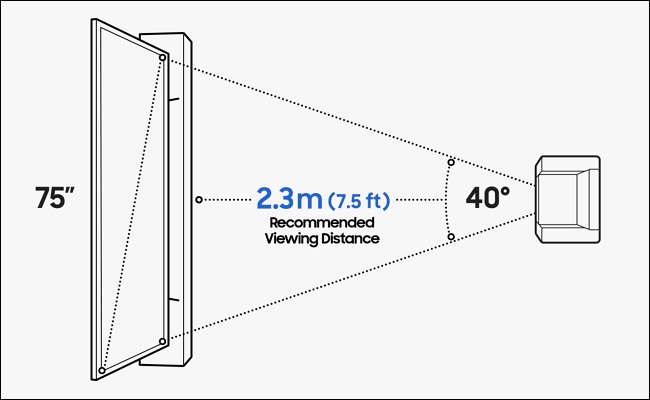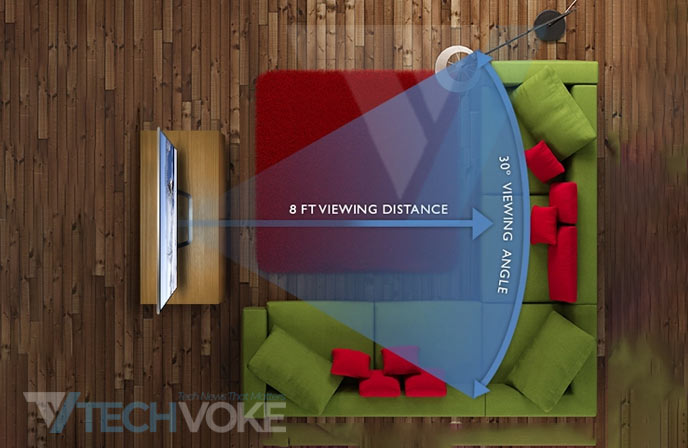To be deeply engaged in an experience, your seating arrangement is important. Sitting too near could make you see pixel-level problems or strain your eyes, but sitting too far away might make you miss important facts.
The Ideal Distance for Watching TV
No one accepted guidelines for the best TV viewing distance, though. Instead, many opinions on the subject, including those from professional associations and manufacturers, make recommendations for how much of a person’s field of vision a screen should obstruct. You may choose the right distance based on screen size using this information.
For instance, the League of Motion Picture and Television Engineers’ advice is one of the most frequently referenced (SMPTE). It suggests a distance at which a display would cover a 30-degree field of view. This distance is approximately 1.62 times the size of a TV show. Therefore, if you have a 55-inch TV, you should sit around 89.1 inches, or 7.42 feet, away from it.
| Screen size | SMPTE Recommended Distance |
| 35-inch | 4.8 feet |
| 40-inch | 5.5 feet |
| 45-inch | 6.1 feet |
| 50-inch | 6.8 feet |
| 55-inch | 7.5 feet |
| 60-inch | 8.2 feet |
| 65-inch | 8.9 feet |
| 70-inch | 9.5 feet |
| 75-inch | 10.2 feet |
| 80-inch | 10.9 feet |
| 85-inch | 11.6 feet |

The high-fidelity audio-visual reference model THX recommends a minimum distance from which the screen covers 40 degrees of your field of view and a maximum length from which the coverage is 28 degrees. To determine the distance by the THX recommendation, multiply the screen size by 1.2 for the lowest and 1.8 for the maximum distance.
| Screen size | THX’s Recommended Distance | THX’s Recommended Maximum Distance |
| 30-inch | 3 feet | 4.5 feet |
| 35-inch | 3.5 feet | 5.25 feet |
| 40-inch | 4 feet | 6 feet |
| 45-inch | 4.5 feet | 6.75 feet |
| 50-inch | 5 feet | 7.5 feet |
| 55-inch | 5.5 feet | 8.25 feet |
| 60-inch | 6 feet | 9 feet |
| 65-inch | 6.5 feet | 9.75 feet |
| 70-inch | 7 feet | 10.50 feet |
| 75-inch | 7.5 feet | 11.25 feet |
| 80-inch | 8 feet | 12 feet |
| 85-inch | 8.5 feet | 12.75 feet |
While SMPTE and THX recommendations are excellent for a comfortable viewing experience and offer a reasonably good estimation of how far you should sit from a screen, both were made for movie theatres. Therefore, people fail to consider how modern high-resolution TVs seem to be. It would be best if you were seated near the screen to see and appreciate the quality of UHD TVs. The higher resolution won’t be useful otherwise.
One of the few TV manufacturers, Sony, offers a suggested viewing distance based on screen size and resolution. The manufacturer claims that 1.5 times the vertical size of the screen should be used as the recommended visual range for 4K TVs. Accordingly, if you have a 55-inch 4K TV, you should sit about 39.36 inches (3.28 feet) away from it.
Similarly, Sony advises a distance of three times the vertical screen size for HD and full-HD TVs and six times for standard definition (SD) TVs. The advice for 4K TVs is an excellent place to start because Sony doesn’t provide a viewing distance for 8K TVs.
Panasonic, among other manufacturers, agrees with Sony’s distance recommendations.
While similar to Sony’s recommendations for HD televisions, TCLs are different because the firm advises a range rather than a fixed distance. Additionally, it requests that tiny size viewers sit close to the TV. Although TCL doesn’t provide a recommended 4K TV viewing distance, it does mention that you can choose to sit closer than is advised for HDTV to experience better quality.
The problem with Sony, Panasonic, and TCL’s advice is that watching lower-resolution video on a higher-resolution TV makes pixel-level flaws more obvious. And if you watch cable, DVDs, YouTube, and older entertainment on 4K TVs, you might see this quite frequently. Therefore, bear this in mind.
Key Factors
While the screen size and resolution serve as an excellent starting point for choosing the best viewing distance, there are a few additional considerations that you should take into account before making your choice, such as what you are watching and who else is watching.
It’s crucial to consider the TV programming you usually watch. If you play a lot of video games or watch a lot of movies, for instance, you might want to sit near your TV to receive the most immersive and cinematic experience. However, you don’t need to be seated close together if you frequently watch TV shows or the news. Similar to this, you risk experiencing momentary eye strain or nausea if you watch fast-moving sports while sitting very near the screen.
Additionally, if you are watching with family or friends and your seats are too near the screen, the vision may not be optimal for others on the side. Therefore, rearranging your seating a little farther will enable everyone to enjoy the information equally.
Which of the recommendations ought you pick?
As you can see, there are many different recommendations available. Therefore, it’s wise to view these suggestions as broad principles and a place to start rather than absolutes. You can select the best distance based on your preferences, eye health, and other relevant information.
The guidelines from SMPTE and THX are appropriate for viewers who don’t need the most immersive experience or don’t want to focus on every nuance of high-resolution visuals. But if you’re looking for both of those features, Sony and TCL’s suggestions are preferable.


